Full Text Searchable PDF User Manual
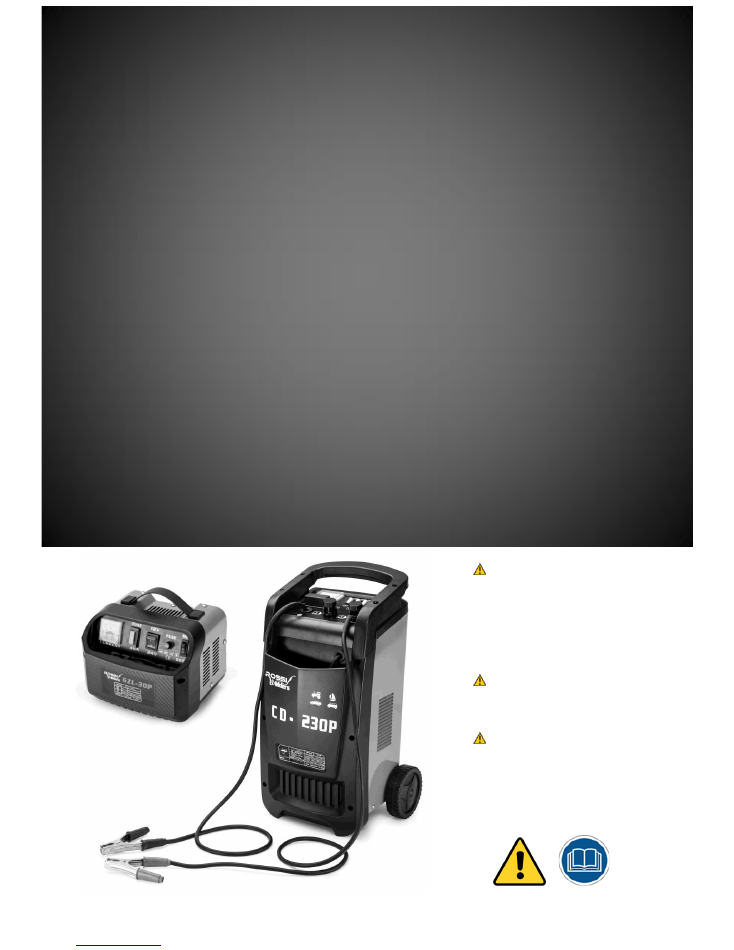
ROSSI Chargers
User Manual
WARNING!
Read and understand all
safety warnings and instructions carefully
before using this machine. Failure to
follow the warnings and instructions may
result in electric shock, fire and/or serious
injury. Save this manual for future
reference
.
ATTENTION!
Products covered by this
manual will vary in appearance, assembly,
inclusions, description and packaging.
NOTE!
This manual covers multiple
styles of product as well as options /
accessories that may not be suitable for
the machine you have purchased.

Product Manual
– Battery Charger / Starter
Index
Index ............................................................................................................................................................. 1
Safety ........................................................................................................................................................... 2
Parts Diagrams ............................................................................................................................................. 5
Assembly (CD-230P, CD-280P & CD-430P models) .................................................................................... 7
Using your Charger ....................................................................................................................................... 8
Charging Mode output (1, 2 & BOOST, MIN options) ................................................................................................... 8
Charging ........................................................................................................................................................................ 8
Battery is installed in a vehicle ...................................................................................................................................... 9
Battery removed / away from vehicle .......................................................................................................................... 10
Using the Engine “Jump Start” feature ........................................................................................................................ 10
General Charging Notes .............................................................................................................................................. 11
Calculating charge time (guide only) ........................................................................................................................... 11
Maintenance ............................................................................................................................................... 11
Fuses ........................................................................................................................................................................... 12
Transporting & Storage ............................................................................................................................... 13
Troubleshooting .......................................................................................................................................... 13
Specifications ............................................................................................................................................. 16
Appendix .................................................................................................................................................... 17
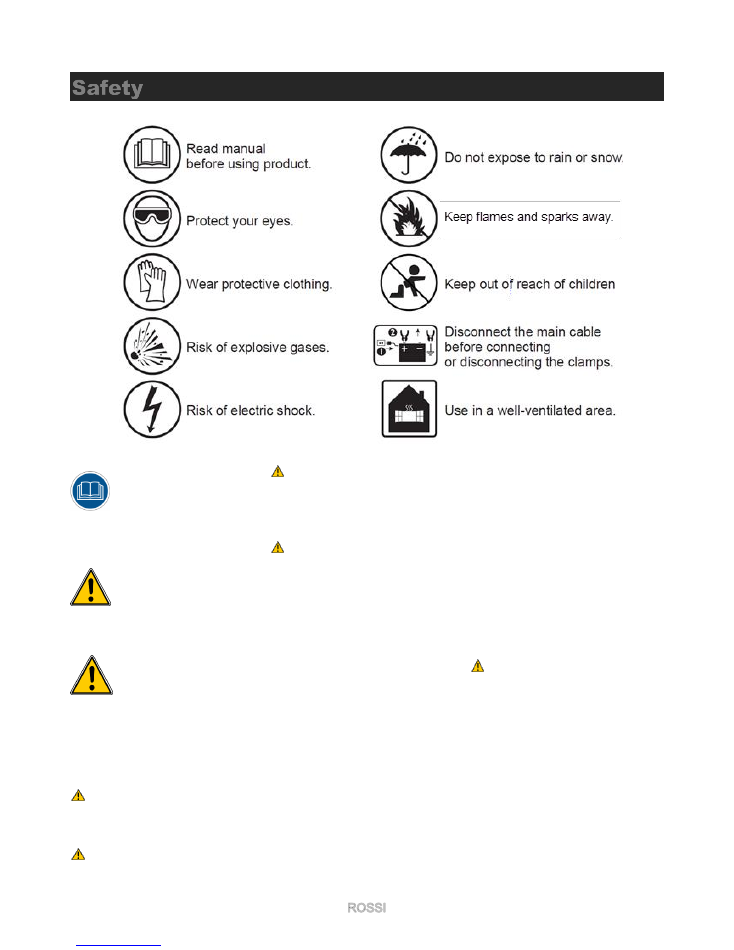
Product Manual
– Battery Charger / Starter
20914092000
2
2
Safety
I
t is important you read
and understand the
instruction manual before
use and keep the manual
in a safe place for future
reference.
Safety precautions must
be observed to reduce the
risk of personal injury
when operating this
machine
.
It is strongly
recommended that a
comprehensive training
course on machine use,
handling and operation be
completed before
attempting to use this
machine.
IMPORTANT! Like all power
equipment this unit must be
handled carefully.
DANGER! Electric Shock can
kill.
DANGER! Exposure to fumes
and gases can damage the
lungs and respiratory system
or cause asphyxiation.
WARNING! Risk of electric
shock or fire.
To reduce the risk of damage to the
electric plug or cord, pull by the plug
rather
than
the
cord
when
disconnecting
the
charger.
An
extension cord should not be used
unless absolutely necessary. Use of
an improper extension cord could
result in a risk of fire and electric
shock. If an extension cord must be
used, make sure:
a. That the pins on the plug of the
extension cord are the same
number, size and shape as those
of the plug on the charger.
b. That the
extension
cord
is
properly wired and in good
electrical condition.
c. That the wire size is large enough
for the AC ampere rating of the
charger.
Do not operate the charger with a
damaged cord or plug; have the cord
or plug replaced immediately by a
qualified service person. Do not
operate the charger if it has received
a sharp blow, been dropped or
otherwise damaged in any way; take it
to a qualified service person. Do not
disassemble the charger; take it to a
qualified service person when service
when repair is required. Incorrect
reassembly may result in a risk of fire
or electric shock.
WARNING! Risk of explosive
gases. Working in the vicinity
of a battery is dangerous.
Batteries generate explosive
gases during normal battery
operation. For this reason, it is
of utmost importance that you
follow the instructions each
time you use the charger.
To reduce the risk of a battery
explosion, follow these instructions
and those published by the battery
manufacturer and the manufacturer of
any equipment you intend to use in
the vicinity of the battery. Review the

Product Manual
– Battery Charger / Starter
20914092000
3
3
cautionary
markings
on
these
products and on the charger.
WARNING! Do not use with non-
rechargeable batteries. Use only
with lead-acid type rechargeable
batteries.
PERSONAL SAFETY
Stay alert, watch what you are doing
and use common sense when
operating equipment. Do not use
equipment while you are tired or
under the influence of drugs, alcohol
or
medication.
A
moment
of
inattention while operating equipment
may result in serious personal injury.
Use personal protective equipment.
Always
wear
eye
protection.
Protective equipment such as dust
mask, non-skid safety shoes, hard
hat, or hearing protection used for
appropriate conditions will reduce
personal
injuries.
Ensure
the
equipment is switched off before
connecting to power source, picking
up or carrying the equipment. Never
carry equipment with your finger on
the switches.
WARNING! Risk of explosive
gases
.
Remove personal metal items such as
rings,
bracelets,
necklaces
and
watches when working with a lead-
acid battery. Batteries can produce a
short circuit current high enough to
weld a ring or the like to metal,
causing a severe burn. Be extra
cautious, to reduce the risk of
dropping a metal tool onto the battery.
It might spark or short-circuit the
battery or other electrical part that
may cause an explosion. Use this
charger for charging 12V or 24V
LEAD-ACID
batteries
only,
only
charge a battery with the same
voltage as the charger is set to. It is
not intended to supply power to a low
voltage electrical system. Do not use
this battery charger for charging dry-
cell batteries that are commonly used
with
home
appliances.
These
batteries may burst and cause injury
to persons and damage to property.
WARNING! NEVER charge a
frozen battery OR overcharge a
battery.
Consider having someone nearby to
come to your aid when you work near
a battery. Have plenty of fresh water
and soap nearby in case battery acid
contacts your skin, clothing or eyes. If
battery acid contacts your skin or
clothing, immediately wash the area
with soap and water. If acid enters
your eye, immediately flood the eye
with cold running water for at least 10
minutes and get medical attention
right
away.
If
battery
acid
is
accidentally swallowed, drink milk, the
whites of eggs or water. DO NOT
induce
vomiting.
Seek
medical
attention immediately.
PREPARING TO CHARGE
WARNING! Risk of contact with
battery acid. Battery acid is a
highly corrosive sulfuric acid.
Remove all cord wraps and uncoil the
cables prior to using the battery
charger. If it is necessary to remove
the battery from the vehicle to charge
it, always remove the grounded
terminal first. Make sure all of the
accessories in the vehicle are off to
prevent arcing. Clean the battery
terminals before charging the battery.
During
cleaning,
keep
airborne
corrosion from coming into contact
with your eyes, nose and mouth. Use
baking soda and water to neutralize
the battery acid and help eliminate
airborne corrosion. Do not touch your
eyes, nose or mouth. Add distilled
water to each cell until the battery
acid reaches the level specified by the
battery manufacturer. Do not overfill.
For a battery without removable cell
caps, such as valve regulated lead
acid batteries (VRLA), carefully follow
the
manufacturer’s
recharging
instructions. Read, understand and
follow all instructions for the charger,
battery, vehicle and any equipment
used near the battery and charger.
Study the battery manufacturer’s
specific precautions while charging
and recommended rates of charge.
Make sure that the charger cable clips
make tight connections.
CHARGER LOCATION
WARNING! Risk of explosion
and contact with battery acid.
Locate the charger as far away from
the battery as the DC cables permit.
Never place the charger directly
above the battery being charged;
gases from the battery will corrode
and damage the charger. Do not set
the battery on top of the charger.
Never allow battery acid to drip onto
the
charger
when
reading
the
electrolyte specific gravity or filling the
battery.
ELECTRICAL SAFETY
WARNING! Risk of electric
shock or fire.
Equipment plugs must match the
outlet. Never modify the plug in any
way. Do not use any adapter plugs
with earthed (grounded) equipment.
Touching live electrical parts can
cause fatal shocks or severe burns.
This battery charger is for use on a
nominal 240V, 50 Hz circuit. The plug
must be plugged into an outlet that is
properly installed and grounded. The
plug pins must fit the receptacle
(outlet).
Do
not
use
with
an
ungrounded system.
DANGER! Never alter the power
cord or plug provided
– if it
does not fit the outlet, have a
proper
grounded
outlet
installed
by
a
qualified
electrician.
An
improper
connection can result in a risk
of
an
electric
shock
or
electrocution.
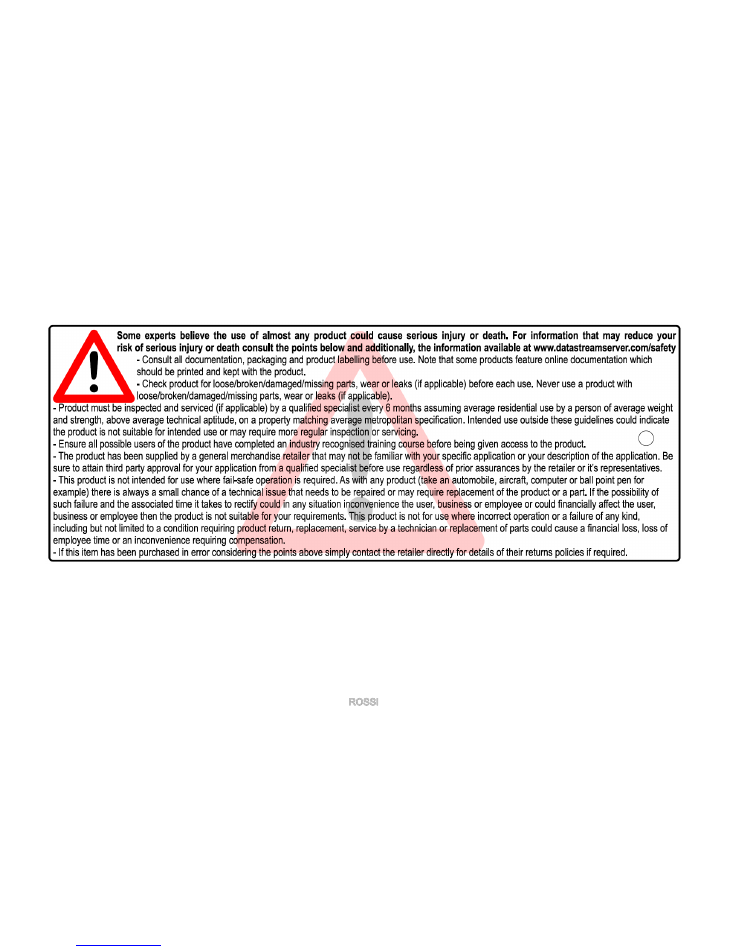
Product Manual
– Battery Charger / Starter
20914092000
4
4
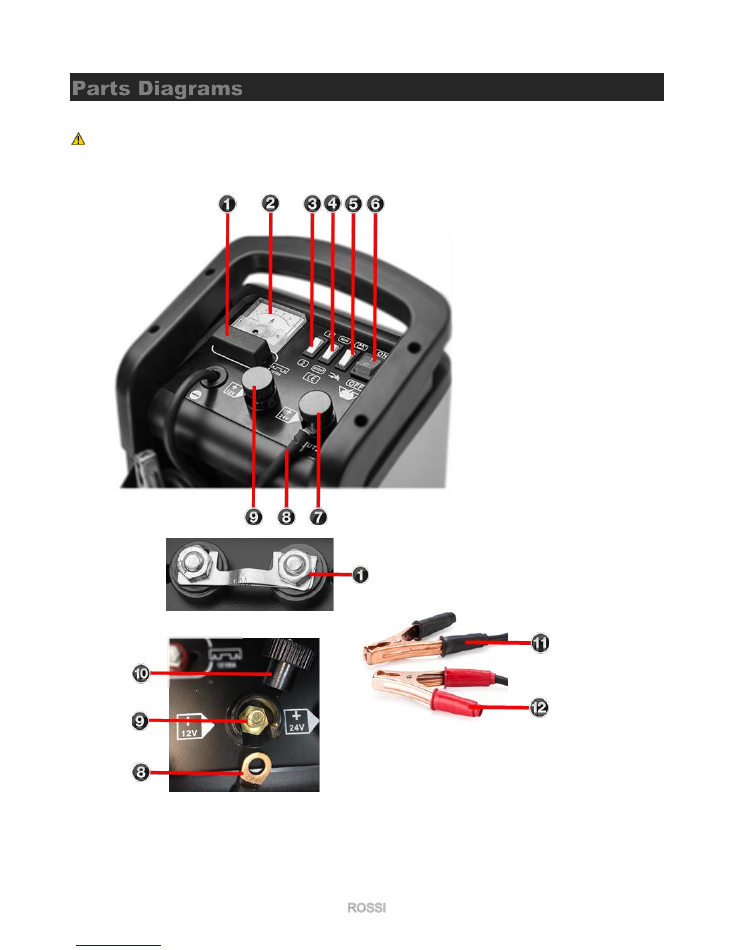
Product Manual
– Battery Charger / Starter
20914092000
5
5
Parts Diagrams
ATTENTION! Products covered by this manual will vary in appearance, assembly, inclusions, description
and packaging.
1. 100 Amp fuse
2. Ammeter
3. 1 / 2 switch
4. MIN / BOOST switch
5. Charge / Jump Start switch
6. Power On/Off
7. 24V terminal
8. Terminal swap cable
9. 12V terminal
10. Terminal CAP
11. Negative (Ground) clamp
12. Positive clamp

Product Manual
– Battery Charger / Starter
20914092000
6
6
1. Ammeter
2. 30A Fuse
3. 12V / 24V mode switch
4. Overheat Fuse
5. MIN / BOOST switch
6. Cable Caddy
7. Power On/Off switch
8. Rear panel
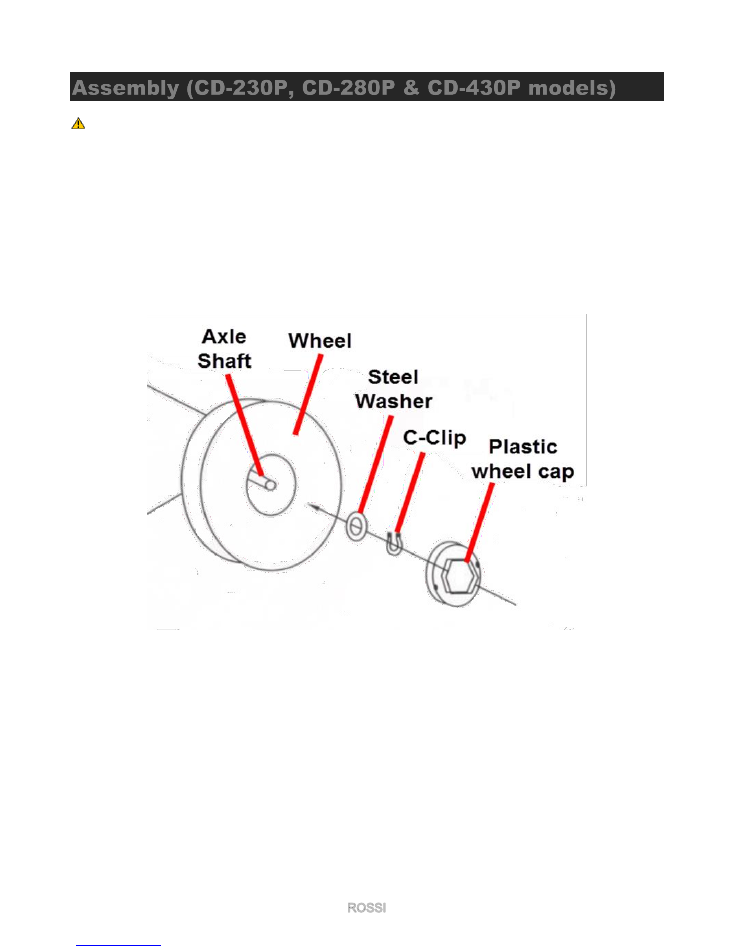
Product Manual
– Battery Charger / Starter
20914092000
7
7
Assembly (CD-230P, CD-280P & CD-430P models)
Note! The GZL-30P does not require any assembly.
1. Lay the charger down on a flat stable surface so you can access the undercarriage.
2. Slide the steel
“axle shaft” into the axle holder on the bottom of the charger leaving some of the
shaft protruding (around 50mm).
3.
Slide on one “wheel” followed by one “steel washer”.
4.
Slide one “C-Clip” into the circular groove around the end of the “axle shaft” until it snaps into place
securely.
5.
Push on the “plastic wheel cap” over the end of the “axle shaft” until it snaps in place. The “wheel”
should lock on to the “C-Clip” installed in step 4.
6. Repeat steps 3
to 5 for the opposite side of the “axle shaft”.
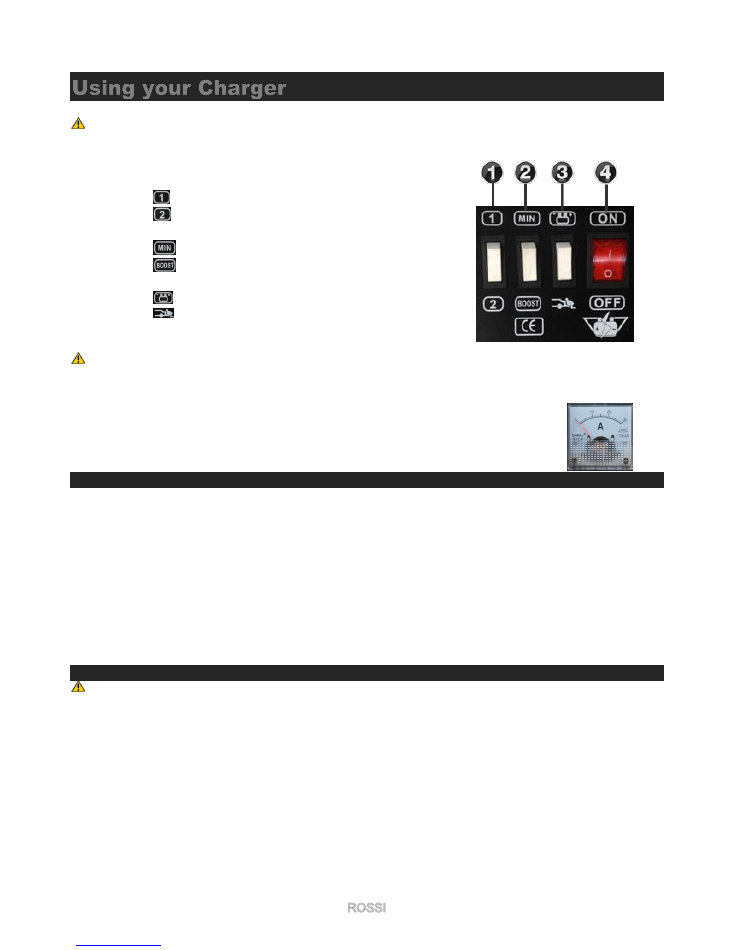
Product Manual
– Battery Charger / Starter
20914092000
8
8
Using your Charger
WARNING! Monitor the charging progress and stop it when the battery is charged. Not doing so may
cause damage to your battery or may cause other personal property damage or personal injury.
1. 1 (min charge and 2 (max charge) under
“Trickle charge mode”
(disabled if Boost is selected)
a.
Low “trickle charge” mode.
b.
High “trickle charge” mode.
2. Boost (full power) / Min (trickle charge)
a.
Trickle charge mode
b.
Boost Charge mode
3. Mode Select
a.
Battery Charge
b.
Jump Start
4. On / Off Switch
NOTE! Some batteries can be very sensitive and damaged if charged with too high an input; consult your battery
manufacturer for support.
Ammeter
The Ammeter indicates the amount of current, measured in amps, that is being drawn by the
battery. As a battery takes on a charge, it draws less current from the charger. Correspondingly,
the meter will show less current being drawn by the battery. When the current stops decreasing,
the battery is charged.
Charging Mode output (1, 2 & BOOST, MIN options)
BT280P (CD230P)
MIN with Button (1) - Charging Current: 26Amp=26000mA; 0.65KW
MIN with Button (2) - Charging Current: 31Amp=31000mA; 0.80KW
BOOST with Button (1) - Charging Current: 33Amp=33000mA; 1.0KW
BOOST with Button (2) - Charging Current: 36Amp=36000mA; 1.30KW
BT750P (CD430P)
MIN with Button (1) - Charging Current: 31Amp=31000mA; 0.80KW
MIN with Button (2) - Charging Current: 36Amp=36000mA; 1.30KW
BOOST with Button (1) - Charging Current: 3Amp=43000mA; 1.6KW
BOOST with Button (2)- Charging Current: 50Amp=50000mA;2.0KW
Charging
NOTE! Check that it is a 12 volt or 24 volt battery you are charging.
1. Place the charge rate to the preferred position (12V or 24V)
2. Ensure that all of the charger components are in place and in good working condition, including the plastic
boots on the battery clips. Make sure the electrolyte (battery liquid) in each cell is at the correct level.
3. Set the mode to Battery Charge and boost to the desired setting (MIN or BOOST)
a. GZL-30P; simply press the switch to select.
b.
All other models; unscrew the “Terminal cap”, move the Terminal swap cable unto the appropriately
marked 12V or 24V terminal.
4. Set the Charge function to the desired setting (1- Low / 2- High).
5. Connect the battery following the precautions listed in this manual.
6. Connect the AC power following the precautions listed in this manual.
7. To disconnect the charger, reverse the procedure.
12V / 24V Charge Rate.
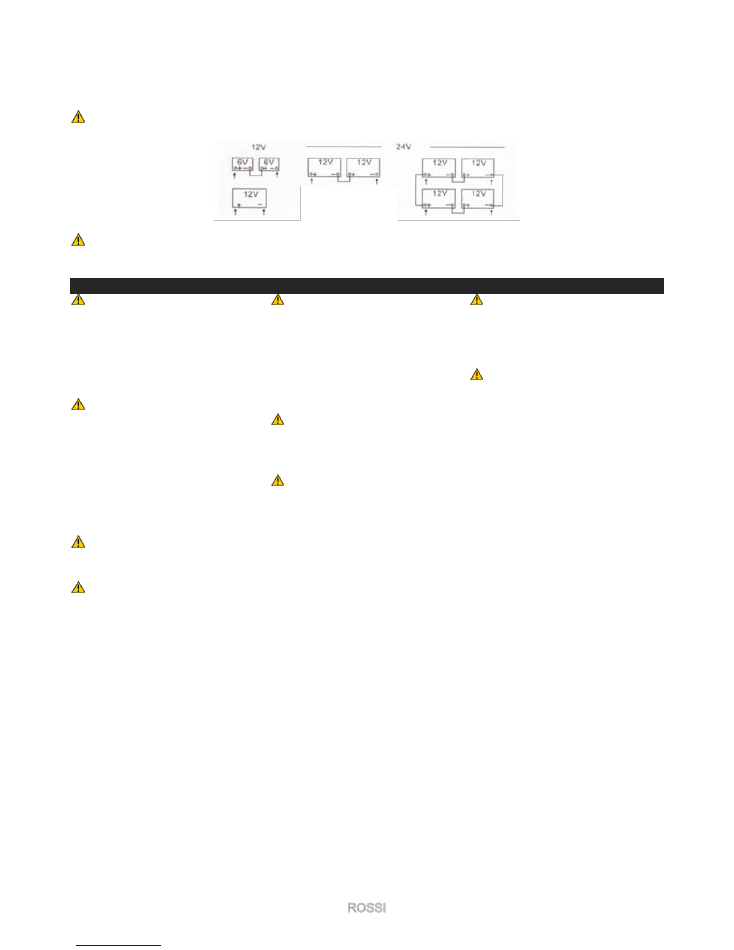
Product Manual
– Battery Charger / Starter
20914092000
9
9
You may select the output voltages of 12 or 24 volts for charging the batteries of those voltages or battery
combinations connected in series (not parallel) in which the sum of the battery voltages adds up to the range selected.
IMPORTANT! Consult an alternative power expert before using this charger to charge multi battery
installations.
WARNING! This is a manual battery charger. Charging must be monitored often to prevent overcharging
of the battery. Overcharging a battery could cause personal injury and/or property damage.
Battery is installed in a vehicle
IMPORTANT!
To reduce the risk
of a spark near the battery,
position the ac and dc cables to
reduce the risk of damage by the
hood, door and moving or hot
engine parts.
IMPORTANT!
Check the polarity
of the battery posts. The positive
(POS, p, +) battery post
sometimes have a larger diameter
than the negative (NEG, n, -) post.
Determine which post of the
battery is grounded (connected)
to the chassis.
NOTE!
Always leave the bonnet
open during charging to ensure
the bonnet does not touch the
metal part of the battery clips.
Stay clear of fan blades, belts,
pulleys and other parts that can
cause injury.
WARNING!
Do not connect the
clip to the carburettor, fuel lines or
sheet-metal body parts.
WARNING!
A spark near the
battery may cause a battery
explosion.
WARNING!
Make sure that the
vehicles are not touching each
other and that the jumper lead
clamps do not touch each other.
NEVER!
Remove the Clamps
while an engine is running, there
is a risk of damaging delicate
computers in a vehicle as well as
risk of battery explosion.
Before proceeding ensure that the ignition of both vehicles and anything that could cause an electrical
load i.e. headlights, interior light etc., are turned off, and keys are removed from the ignition of both
vehicles.
Before charging or jump starting always consult the vehicle manufacturer or your Vehicles manual for
more advice and techniques on how to jump start your vehicle to reduce and risk to electrical equipment /
computers.
For a negative-grounded vehicle:
a. Connect the POSITIVE (RED) clip from the battery charger to the POSITIVE (POS, P, +) ungrounded post of
the battery.
b. Connect the NEGATIVE (BLACK, NEG, N, -) clip to the vehicle chassis or engine block away from the battery.
c. Connect to a heavy gauge metal part of the frame or engine block.
d. Connect charger AC supply cord to electrical outlet. When disconnecting the charger, disconnect the AC cord,
remove the clip from the vehicle chassis and then remove the clip from the battery terminal.
For a positive-grounded vehicle:
a. Connect the NEGATIVE (BLACK) clip from the battery charger to the NEGATIVE (NEG, N, -) ungrounded
post of the battery.
b. Connect the POSITIVE (RED) clip to the vehicle chassis or engine block away from the battery.
c. Connect to a heavy gauge metal part of the frame or engine block.
d. Connect charger AC supply cord to electrical outlet. When disconnecting the charger, disconnect the AC
cord, remove the clip from the vehicle chassis and then remove the clip from the battery terminal.
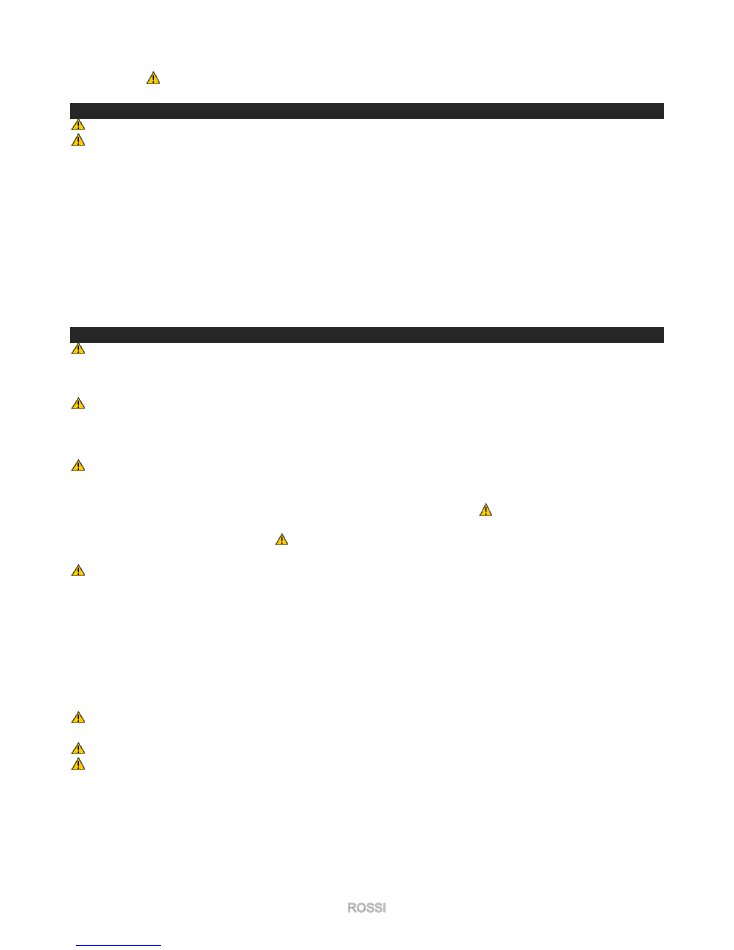
Product Manual
– Battery Charger / Starter
20914092000
10
10
NOTE! See section
“Calculating charge time” for length of charge information.
Battery removed / away from vehicle
WARNING! A spark near the battery may cause a battery explosion.
WARNING! Do not face the battery when making the final connection.
TO REDUCE THE RISK OF A SPARK NEAR THE BATTERY:
-
Check the polarity of the battery posts. The POSITIVE (POS, P, +) battery post often has a larger diameter
than the NEGATIVE (NEG, N, -) post.
-
Connect the POSITIVE (RED) charger clip to the POSITIVE (POS, P, +) post of the battery.
-
Position yourself and the free end of the cable you previously attached to the NEGATIVE (NEG, N, -) battery
post as far away from the battery as possible
– then connect the NEGATIVE (BLACK) charger clip to the free
end of the cable.
-
Connect charger AC supply cord to electrical outlet. When disconnecting the charger, always do so in the
reverse order of the connecting procedure and break the first connection while as far away from the battery as
practical. A marine (boat) battery must be removed and charged on shore.
Using the Engine “Jump Start” feature
CD-230P, CD-280P & CD-430P models only.
Your battery charger can be used to jumpstart your car if the battery is low. Follow these instructions on how to use
the ENGINE START feature.
Before charging or jump starting always consult the vehicle manufacturer or your Vehicles
manual for more advice and techniques on how to jump start your vehicle to reduce and risk to
electrical equipment / computers.
WARNING!
Follow all safety
instructions and precautions for
charging your battery. Wear
complete eye protection and
clothing protection. Charge your
battery in a well-ventilated area.
IMPORTANT!
Using the
ENGINE START feature
WITHOUT a battery installed in
the vehicle could cause damage
to the vehicle’s electrical
system.
NOTE!
If you have charged the
battery and it still will not start
your car, do not use the engine
start feature, or it could
damage
the vehicle’s electrical system.
IMPORTANT!
Do not leave the
charger in ENGINE START
Mode for more than ten minutes
at a time; this may damage the
charger.
1. With the charger unplugged from the AC outlet, connect the charger to the battery, following the instructions
given in previous section
“Battery is installed in a vehicle”.
2. Plug the charger AC power cord into the AC outlet.
3. With the charger plugged in and connected to the battery of the vehicle, set the mode selector switch to the
“jump start” position.
4. Crank the engine until it starts or 3 seconds pass. If the engine does not start, set the jump stater to charge
mode and wait 15min minutes before trying again.
NOTE! During extremely cold weather, or if the battery is under 2 volts, charge the battery for 15 minutes
before cranking the engine.
IMPORTANT! Never charge frozen batteries.
NOTE! When starting a diesel motor; allow the glow plugs to warm up prior to cranking the engine.
5. If the engine fails to start, charge the battery for 10 more minutes before attempting to crank the engine again.
6. After the engine starts, move the charge mode selector switch to the OFF position and unplug the AC power
cord before disconnecting the battery clips from the vehicle.
7. Clean and store the charger in a dry location.
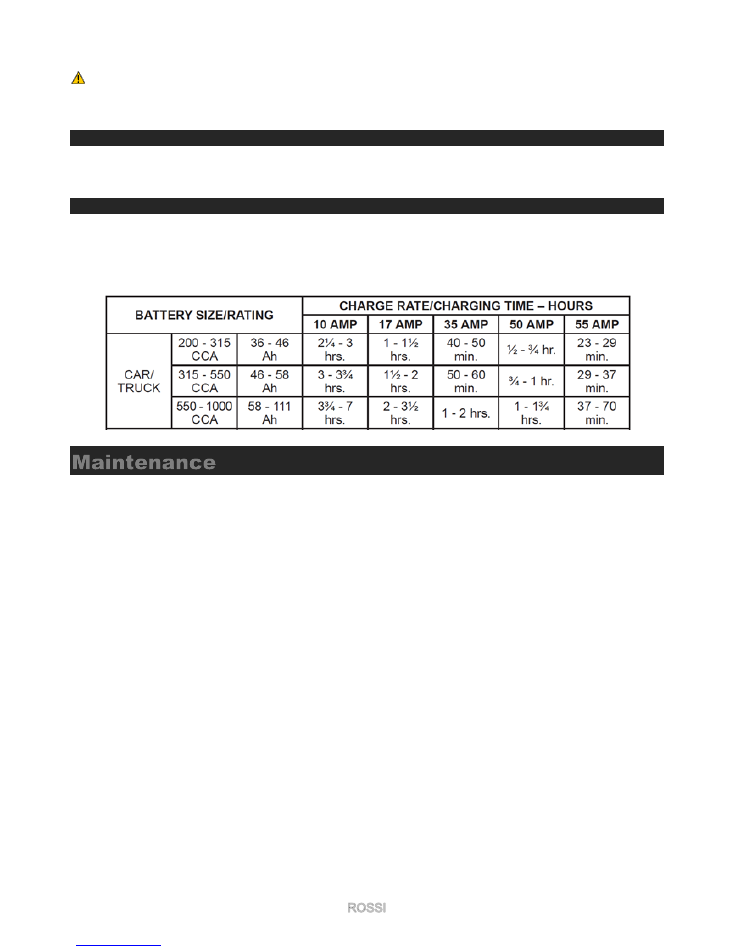
Product Manual
– Battery Charger / Starter
20914092000
11
11
NOTE: If the engine does turn over but never starts, there is not a problem with the starting system; there
is a problem somewhere else with the vehicle. STOP cranking the engine until the other problem has been
diagnosed and corrected.
General Charging Notes
Cooling Fans:
The charger is designed to control its cooling fan for efficient operation. Keep the area near the
charger clear of obstructions to allow the fan to operate efficiently.
Calculating charge time (guide only)
Use the following table to more accurately determine the time it will take to bring a battery to full charge. First, identify
where your battery fits into the chart. NR means that the charger setting is NOT RECOMMENDED. Find your battery’s
rating on the chart, and note the charge time given for each charger setting. The times given are for batteries with a
50% charge prior to recharging. Add more time for severely discharged batteries.
Maintenance
-
After use and before performing maintenance, unplug and disconnect the battery charger.
-
Use a dry cloth to wipe all battery corrosion and other dirt or oil from the battery clips, cords and the charger
case.
-
Ensure that all of the charger components are in place and in good working condition, for example, the plastic
boots on the battery clips.
-
Servicing does not require opening the unit, as there are no user-serviceable parts.
-
All other servicing should be performed by qualified service personnel.
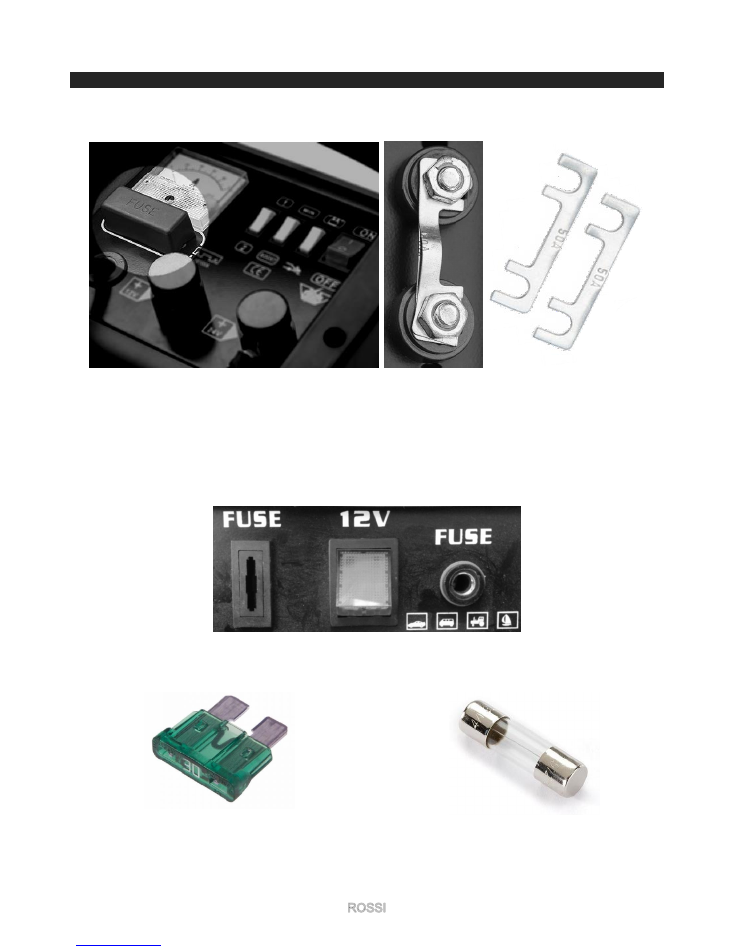
Product Manual
– Battery Charger / Starter
20914092000
12
12
Fuses
CD-230P, CD-280P & CD-430P models
100 Amp Fuse
– Replace the fuse with
2
of the supplied
50Amp
blades or use 2 strands of 50Amp fuse wire
(doubled) to make 100Amp.
GZL30P models
30 Amp Blade Fuse
(Output)
5 Amp, 250V glass fuse (F5AL250V)
(Input)
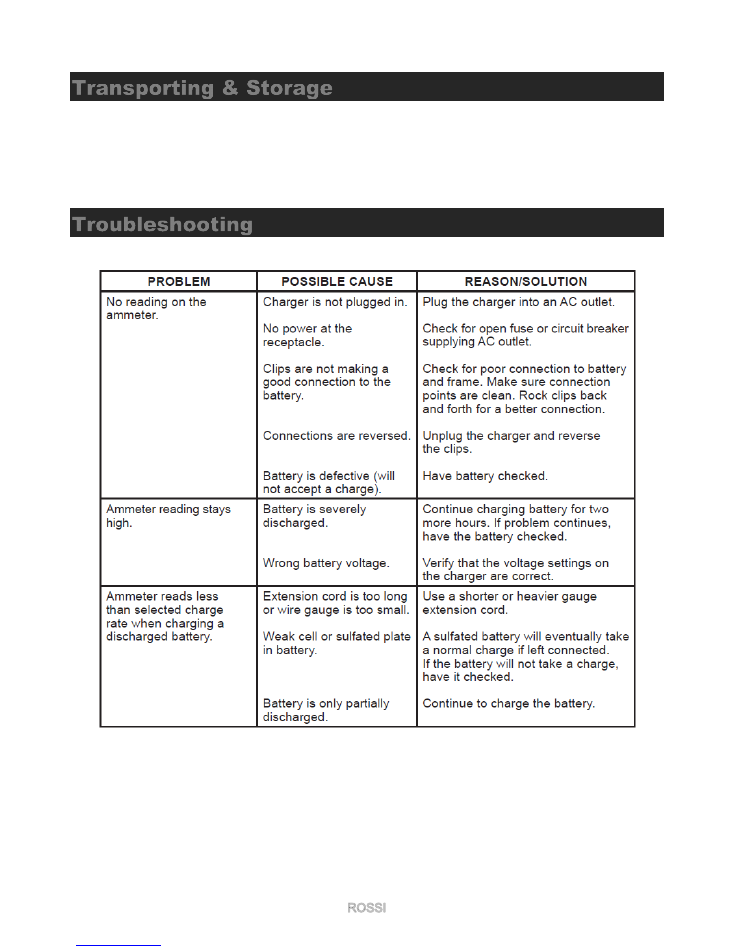
Product Manual
– Battery Charger / Starter
20914092000
13
13
Transporting & Storage
-
Store the charger unplugged, in an upright position. The cord will still conduct electricity until it is unplugged
from the outlet.
-
If the charger is moved around the shop or transported to another location, take care to avoid/prevent damage
to the cords, clips and charger. Failure to do so could result in personal injury or property damage. Store the
clips on the fiberglass clamp rod. Do not store them on the handle, clipped together, on or around metal, or
clipped to the cables.
Troubleshooting
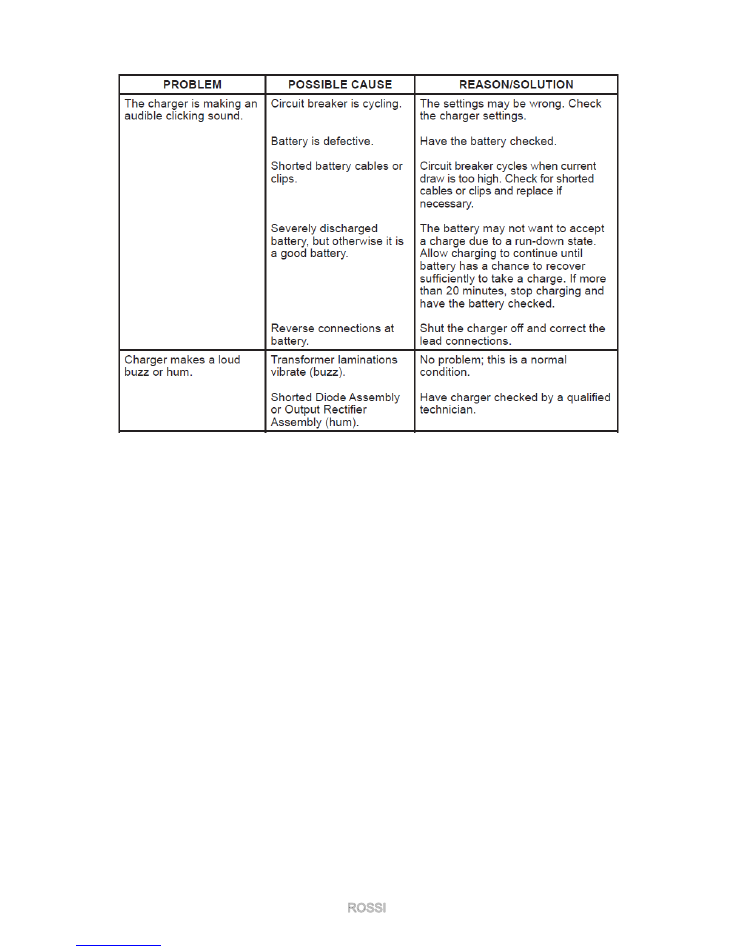
Product Manual
– Battery Charger / Starter
20914092000
14
14
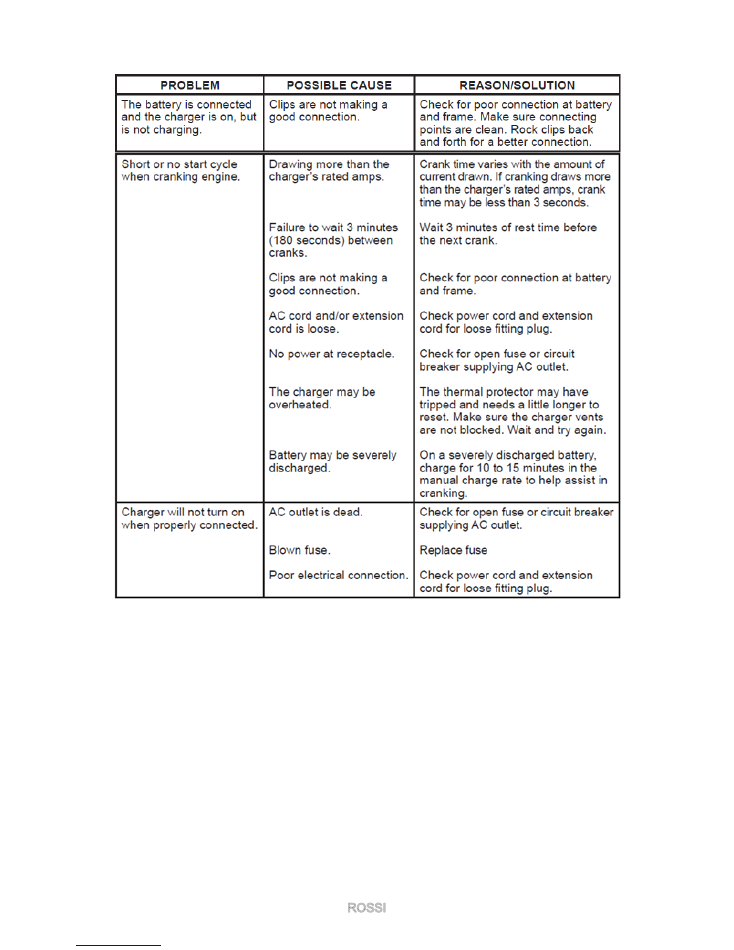
Product Manual
– Battery Charger / Starter
20914092000
15
15
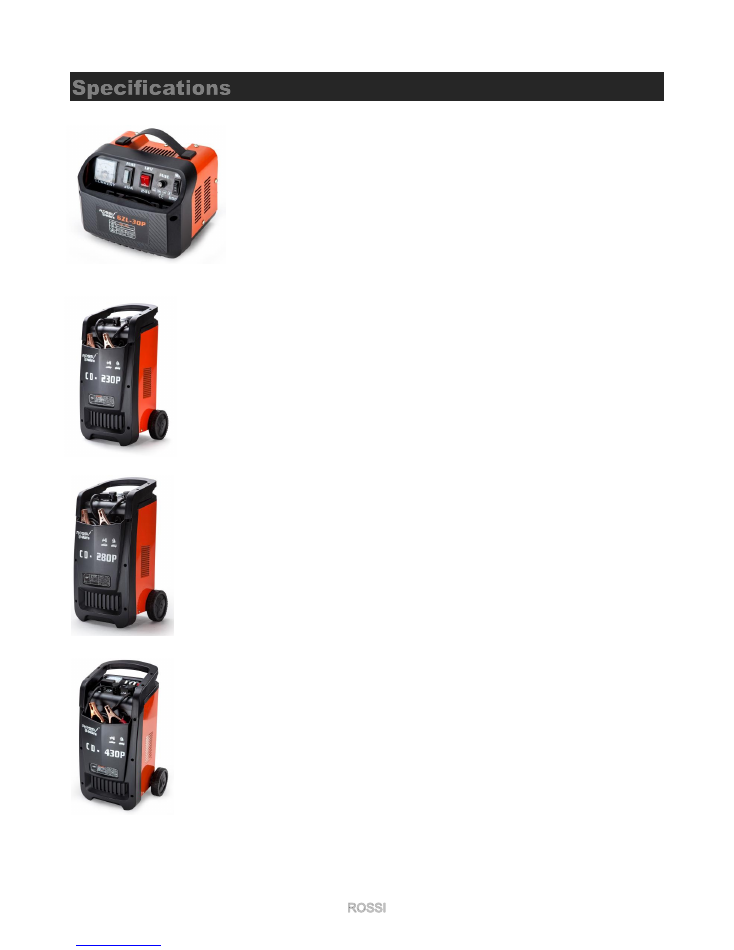
Product Manual
– Battery Charger / Starter
20914092000
16
16
Specifications
GZL30P - SINGLE PHASE 12V/24V BATTERY CHARGER
Manufacturer: ROSSI
Jump Start feature: No
Input Voltage: 220-240V 50Hz
Charger type: Manual
Charge Voltage: 12V/24V
Rated Charging Power: 1kW
Rated Output Current: 30A
Battery Capacity: 60-200Ah
Fuse: 30A
CD-230P - SINGLE PHASE 12V/24V 280A BATTERY CHARGER
Manufacturer: ROSSI
Jump Start feature: Yes
Input Voltage: 220-240V 50Hz
Charger type: Manual
Charge Voltage: 12V/24V
Rated Charging Power: 1kW
Rated Starting Power: 6.4kW
Start Power 12V/24V: 180A
Rated Charging Current: 30A (12V), 40A (24V)
Fuse: 100A
CD-280P - SINGLE PHASE 12V/24V 280A BATTERY CHARGER
Manufacturer: ROSSI
Jump Start feature: Yes
Input Voltage: 220-240V 50Hz
Charger type: Manual
Charge Voltage: 12V/24V
Rated Charging Power: 1kW
Rated Starting Power: 6.4kW
Start Power 12V/24V: 280A
Rated Charging Current: 30A (12V), 40A (24V)
Fuse: 100A
CD-430P - SINGLE PHASE 12V/24V 280A BATTERY CHARGER
Manufacturer: ROSSI
Jump Start feature: Yes
Input Voltage: 220-240V 50Hz
Charger type: Manual
Charge Voltage: 12V/24V
Rated Charging Power: 1.6kW
Rated Starting Power: 10kW
Start Power 12V/24V: 430A
Rated Charging Current: 50A (12V), 60A (24V)
Fuse: 100A

Product Manual
– Battery Charger / Starter
20914092000
17
17
Appendix
© Copyright 2012 - Mills International Trading Pty Ltd
.